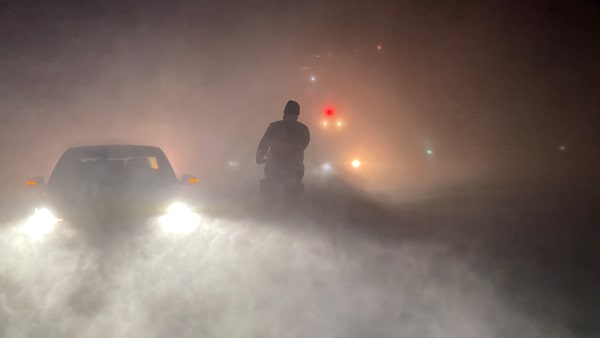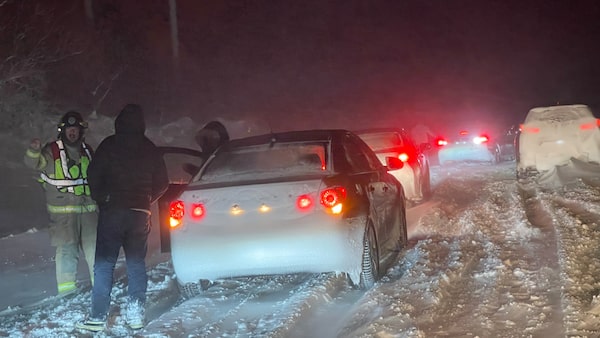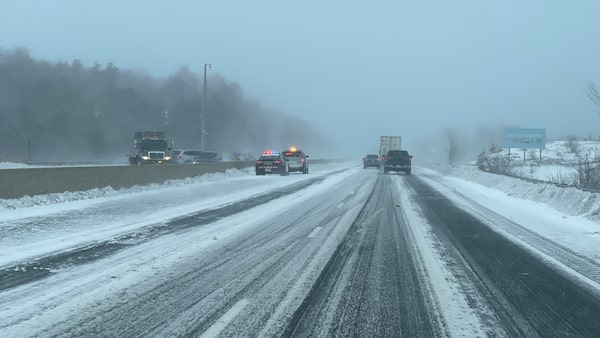
The view out of Mark Richardson's windshield on Dundonald Rd. near Brighton, Ont., on the evening of Dec. 23.Mark Richardson/The Globe and Mail
It can sound like a broken record, when the mayor and the politicians tell us to “just stay home” and not drive. Every winter, we hear the same thing: Don’t drive. There’s a winter storm. Stay home. And every winter, many of us ignore the pleas because we think they don’t apply to us. We’ll be okay – until we’re not.
On Friday, Dec. 23, I drove along the north shore of Lake Ontario to bring my 25-year-old son home from the bus terminal in Kingston. The winter storm waring was in full effect but the winds hadn’t yet reached their height – I figured if the bus wasn’t cancelled and he could make it to Kingston from Ottawa, then I could make the 300 kilometres from Cobourg to Kingston and back.
I was as prepared as I could be: my all-wheel-drive Toyota RAV4 SUV had new Sailun winter performance tires fitted, and I carried a winter emergency kit with blankets, flares, a tow-rope and a proper shovel. There were two chocolate bars, but I ate them on the drive to Kingston. I also carried winter boots, gloves and an Arctic-quality jacket with a double-lined hat. To top all that, I’ve attended many winter driving courses that teach how to control skids. If the bus was getting through, then so was I.
It was a fairly relaxed drive to Kingston. The normally 90 minute-drive took two hours as I kept my speed down on Highway 401. I arrived early to find most of the fast-food restaurants closed because the storm had knocked out power. Winds were gusting to 120 kilometres per hour, said the radio, and the wind chill was minus-20 degrees. Authorities warned drivers to stay off the roads because white-outs were frequent and there had been a pile-up on the 401 near London, but the bus arrived only 15 minutes late and all was well.
I topped up the half-full gas tank and we headed home just as the sun set. With the darkness, everything changed.
There were bare tracks on the two-lane asphalt for much of the way there, but the snow blew directly onto the windshield and obscured the road ahead. I slowed way down and tucked far behind another vehicle, and others did the same behind me. We stayed in the right lane and our speed held to 30 or 20 kilometres per hour. We all used our flashers, and a few times, we came to almost a stop as our little convoy was engulfed by fierce, blinding snow.
Even the best prepared vehicle and the best driver are worthless if the driver can’t see the road.

Two firefighters told Mark to keep going, to at least get his vehicle off the road.Mark Richardson/The Globe and Mail
My son checked the highway reports on his phone and said the road was closed ahead, near Brighton. I could have turned off at Trenton and taken the parallel road of Highway 2, but it seemed safer to crawl with other traffic than be alone on a country road, unable to see the ditches to the sides. So we stayed on Highway 401, right until traffic ground to a halt.
It took 3.5 hours to drive four kilometres to the next exit. Apparently, traffic was being routed there off the highway, but when we arrived, there was nothing – no cops or rescue vehicles, just a line of cars and trucks barely moving on their way to Highway 2. A Twitter report said the highway was now open but nobody believed it, and I didn’t want to risk heading into the obscurity with impatient drivers coming up from behind. It looked like it would take hours to detour to the next exit.
So instead of heading south to Highway 2, I drove north, to the next parallel road. I know this area and I ride this road often on my motorcycle – there are trees to each side that should help temper the wind. Others had the same idea. We took off north, happy to be moving, and then turned west on the Dundonald Road.
The road was unplowed and our tires rutted deep tracks in the snow, but our new convoy made good progress right until we reached the community of Dundonald. That’s where the road twists in a broad S-bend and then climbs a long hill. A steep, unplowed, wind-wrecked hill. A dozen tractor-trailers were parked at the bottom, not even bothering to try the ascent and unable to turn around on the narrow country road. And near the top, an SUV was stalled, and beside it, a Volkswagen Passat, its tires spinning uselessly in the snow.
Traffic built behind us, including a pair of Cramahe township firefighters in a pickup truck towing a trailer. Nobody could get past. Nobody could back up. Those of us with warm jackets tried pushing the stuck car and it eventually moved a few feet to the side, leaving space for me to drive past and hook up my tow rope, except I couldn’t find anywhere to fix the hook on the Passat. Everything on the front of the car was embedded in snow and ice. The driver stayed inside with his family.
“It’s all-wheel drive,” he said, “but they’re all-season tires. I thought we’d be okay. I didn’t expect this.”

Driving east on Highway 401 near Brighton, Ont.Mark Richardson/The Globe and Mail
The two firefighters told me to keep going, to at least get my vehicle off the road. They’d wait for a plow, except no plows were running that night. Visibility was too poor and it was no place to be outside for long on the road, rolling around in the snow, looking for a car’s tow hook beneath the ice.
“I can’t feel my face,” said one of the firefighters. “We’ve been in this for two hours. This is just brutal.”
I drove on, and just around the corner, a hatchback was in the ditch. Its driver said he and his partner and their little dog had been there for three hours. He said he had winter tires and all-wheel drive and asked for a shovel, but after shovelling for a few minutes, it was clear the car wasn’t driving out of there. Again, he had no idea what to hook my rope to. It was a rental, and he didn’t want to damage it.
A pickup truck drove by toward the hill, then turned around when its driver saw the road was blocked. She leaned out her window as she drove back, at speed, and yelled at us.
“Stupid people shouldn’t be allowed to drive out here,” she called. “Get off the road!”
The couple in the hatchback had plenty of gas, so I told them about the traffic just around the corner and then left them to the elements. I remember them looking up at me from the isolation of their car, the passenger clutching her little dog, scared, realizing fully they should never have tried to drive that day.
Farther along, the road was filled with much deeper snow and the RAV4 churned through – its WSTX tires made all the difference. The hatchback and the Passat were going nowhere until the road was plowed, and it wouldn’t be plowed until the next day.
I drove the last half-hour home through deep snow drifts and arrived at midnight. The next day, I read on the news of how more than 500 people were waiting out the storm at the local community centre in Cramahe Township, rescued from their cars and trucks and buses.
Was is worth it for my son to be home for Christmas? Well, we made it, but we were lucky nobody crashed into us, and that I didn’t drive into a ditch, disoriented by the blinding snow. If we had, we’d be at that community centre now or in a hospital, one more headache for the overworked emergency workers.
All the training, all the equipment, all the preparations – nothing replaces staying home and waiting out the storm. Nothing.